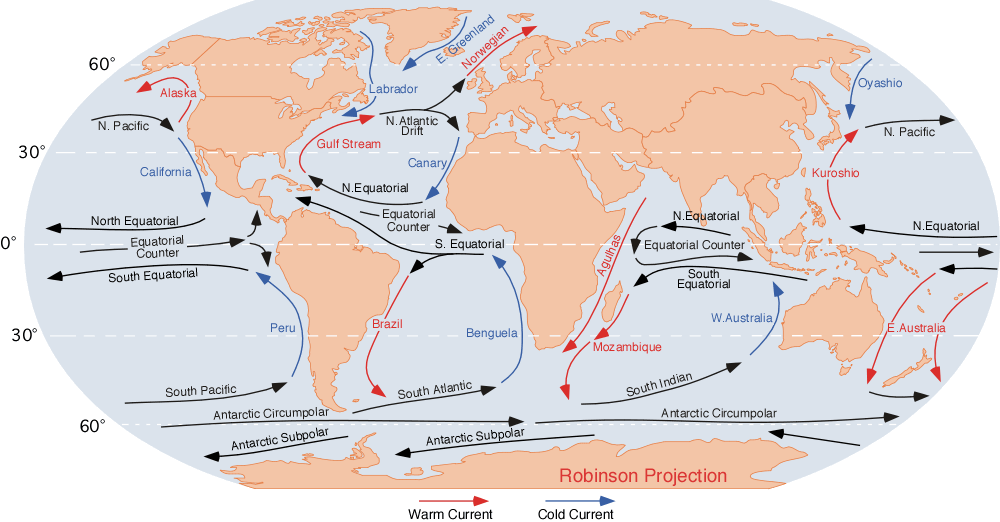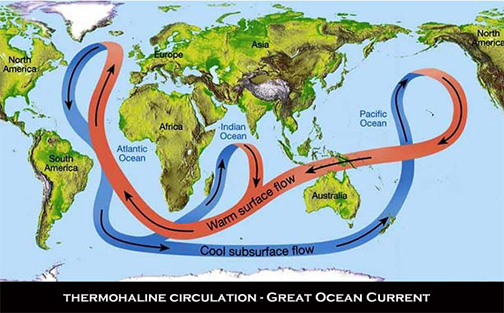Atlantic Ocean Current System: AMOC | 10 Aug 2021
Why in News
According to the recently released IPCC’s Report, Atlantic Meridional Overturning Circulation (AMOC) is losing its stability and is very likely to decline over the 21st century.
- The ocean has an interconnected current, or circulation, system powered by wind, tides, the Earth’s rotation (Coriolis effect), the sun (solar energy), and water density differences.
Key Points
- About AMOC:
- It is a large system of ocean currents.
- It is the Atlantic branch of the ocean conveyor belt or ThermoHaline Circulation (THC), and distributes heat and nutrients throughout the world’s ocean basins.
- Working of AMOC:
- AMOC carries warm surface waters from the tropics towards the Northern Hemisphere, where it cools and sinks.
- It then returns to the tropics and then to the South Atlantic as a bottom current. From there it is distributed to all ocean basins via the Antarctic Circumpolar Current.
- The ACC is the most important current in the Southern Ocean, and the only current that flows completely around the globe.
- Implications of decline of AMOC:
- Without a proper AMOC and Gulf Stream, Europe will be very cold.
- Gulf Stream, a part of the AMOC, is a warm current responsible for mild climate at the Eastern coast of North America as well as Europe.
- An AMOC shutdown would cool the northern hemisphere and decrease rainfall over Europe.
- It can also have an effect on the El Nino.
- El Nino is a climate pattern that describes the unusual warming of surface waters in the eastern tropical Pacific Ocean.
- It can also shift monsoons in South America and Africa.
- Without a proper AMOC and Gulf Stream, Europe will be very cold.
- Causes:
- Climate models have long predicted that global warming can cause a weakening of the major ocean systems of the world.
- Freshwater inflow from the melting of the Greenland ice sheet.
- In July 2021, researchers noted that a part of the Arctic’s ice called “Last Ice Area” has also melted.
- The freshwater from the melting ice reduces the salinity and density of the water.
- Now, the water is unable to sink as it used to and weakens the AMOC flow.
- Indian Ocean may also be helping the slowing down of AMOC.
- Increasing precipitation and river run-off.
- Importance of AMOC:
- It plays a critical role in redistributing heat and regulating weather patterns around the world.
- Concerns:
- The AMOC decline is not just a fluctuation or a linear response to increasing temperatures but likely means the approaching of a critical threshold beyond which the circulation system could collapse.
Ocean Currents
- About:
- Ocean currents are located at the ocean surface and in deep water below 300 meters. They can move water horizontally and vertically and occur on both local and global scales.
- Surface Currents:
- Surface currents in the ocean are driven by global wind systems that are fueled by energy from the sun. Patterns of surface currents are determined by wind direction, Coriolis forces from the Earth’s rotation, and the position of landforms that interact with the currents.
- Surface wind-driven currents generate upwelling currents in conjunction with landforms, creating deepwater currents.
- Upwelling is a process in which deep, cold water rises toward the surface.
- Along the east coast of the US, the Gulf Stream carries warm water from the equatorial region to the North Atlantic Ocean, keeping the southeast coast relatively warm.
- Along the west coast of the US, the California Current carries cold water from the polar region southward, keeping the west coast relatively cooler than the east coast.
- Gyre, is a vast circular system made up of ocean currents that spirals about a central point.
- Such as the Gulf Stream–North Atlantic–Norway Current in the Atlantic Ocean and the Kuroshio–North Pacific Current in the Pacific Ocean.
- Deep Water Currents:
- Currents may also be caused by density differences in water masses due to temperature (thermo) and salinity (haline) variations via a process known as thermohaline circulation.
- These currents move water masses through the deep ocean—taking nutrients, oxygen, and heat with them.
- Conveyor Belt:
- Density differences in ocean water contribute to a global-scale circulation system, also called the global conveyor belt. It includes both surface and deep ocean currents that circulate the globe in a 1,000-year cycle.
- The global conveyor belt’s circulation is the result of two simultaneous processes: warm surface currents carrying less dense water away from the Equator toward the poles, and cold deep ocean currents carrying denser water away from the poles toward the Equator.
- The ocean’s global circulation system plays a key role in distributing heat energy, regulating weather and climate, and cycling vital nutrients and gases.


